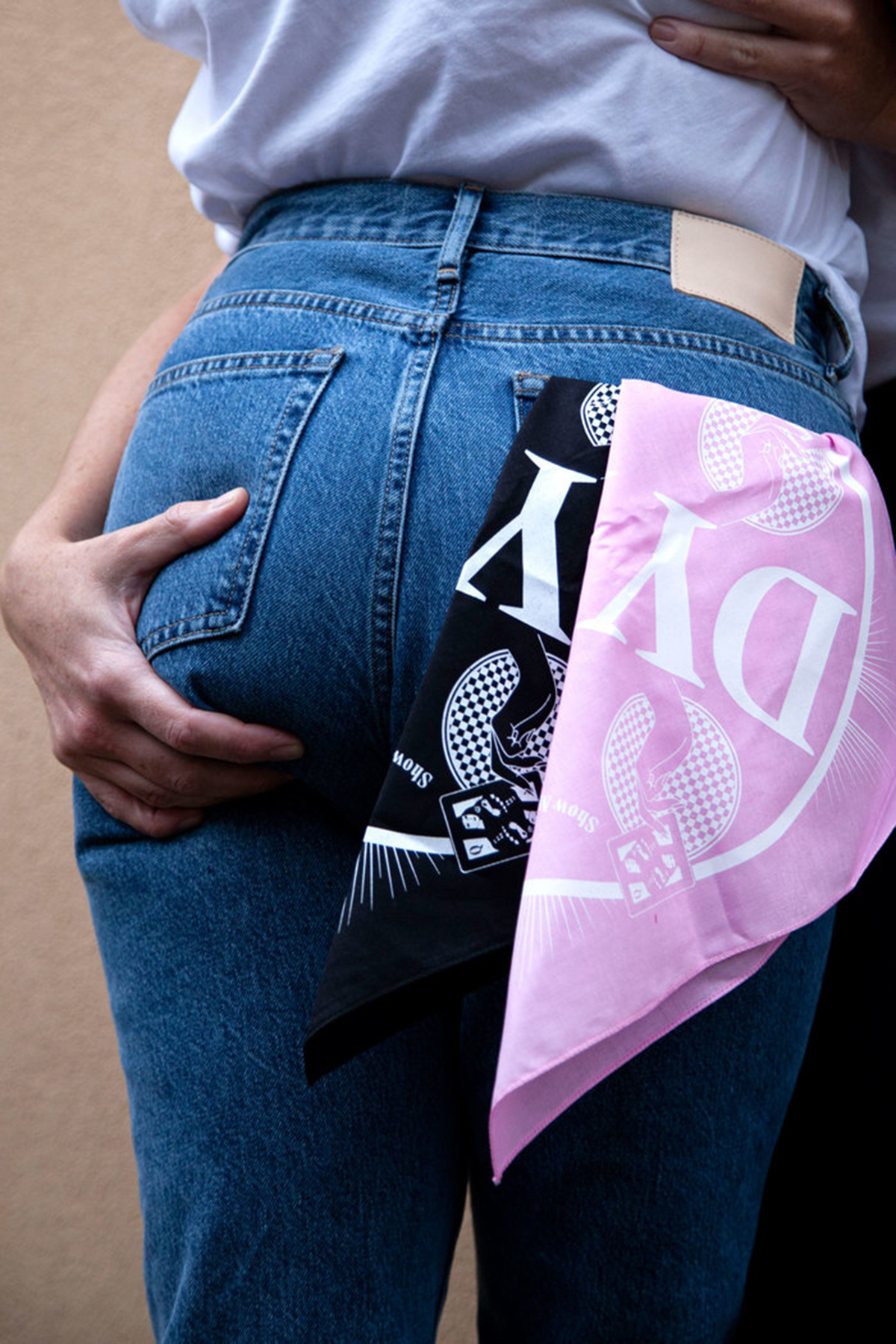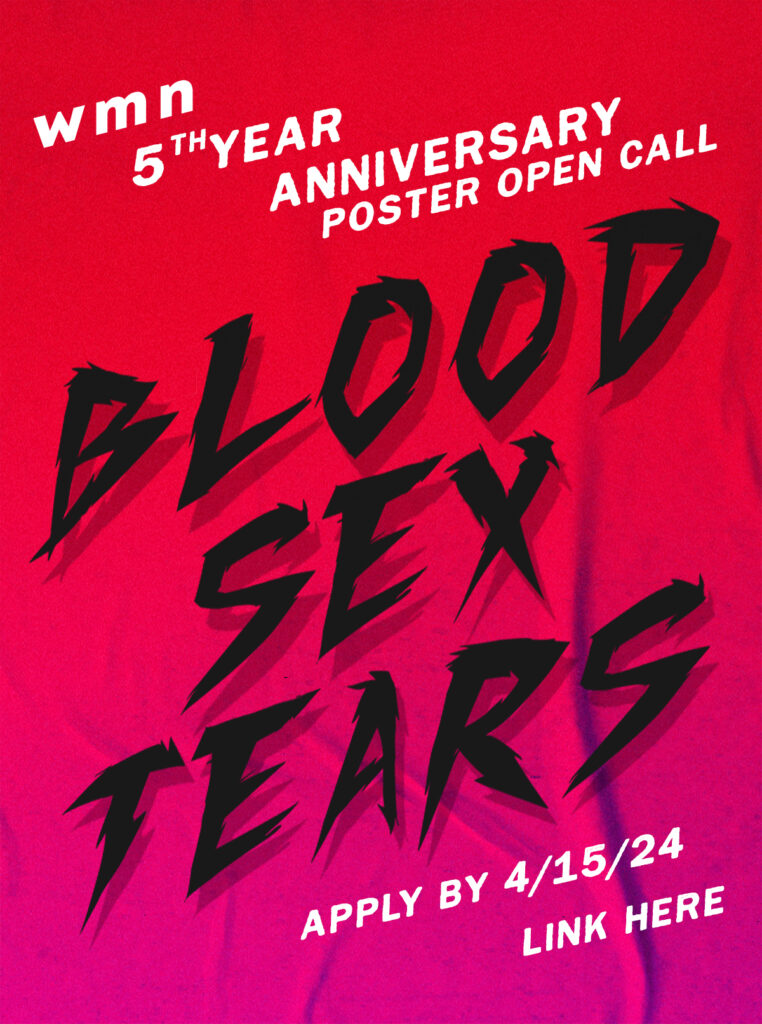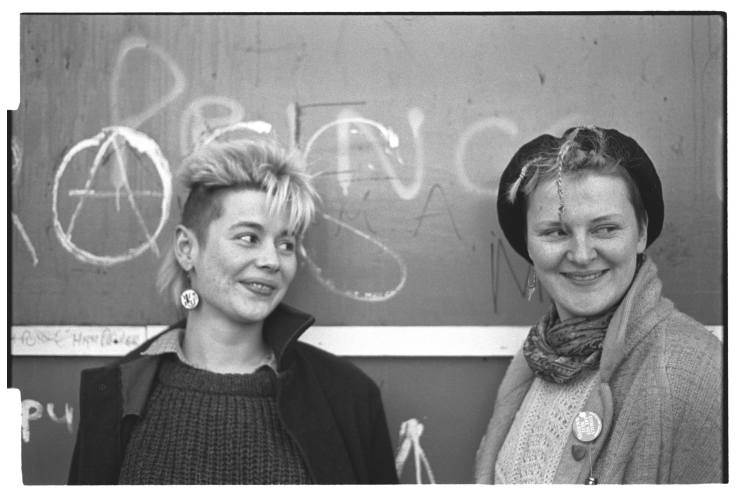A history of the hanky code and an appeal to the maker of the “New Women’s Hanky Code”.
By Brooke Palmieri of CAMP BOOKS

I want to trace histories of desire, its textures and forms, the way it has manifested amidst the moving targets we try to pin down as ‘gender’ and ‘sexuality’ over time. I love the hanky code because it depends upon—in theory—clarity, communication, and consent, at the same time as it highlights the contingencies of desire. There are several hanky codes. Some of them assign colors to kinks differently, but no one really argues about it. And I think that’s great! In a world where we are still living with the damage that Imperialist-Enlightenment hierarchies of knowledge have wrought upon humanity, I think we really need something like the hanky code, which provides potentially useful information at the same time as it seems to allow us to laugh about how miserable we risk making ourselves with cataloguing and absolutes. As usual, within crushingly oppressive systems, kink advises that the only way out is through.
“As usual, within crushingly oppressive systems, kink advises that the only way out is through.”
Color-coding is hard to separate from the past 50 years of LGBTQIA+ activism. Gilbert Baker’s pride flag, first flown in 1978 assigned meanings to each color of the rainbow, a practice that has become tradition both in Baker’s lifetime with the addition of colors like lavender, and with initiatives like Philadelphia’s 2017 “More Color, More Pride” project, and Daniel Quasar’s “Progress” flag. If flags otherwise have an upsetting relationship to nationalism and imperialism—we’re back to the horrors of the so-called Enlightenment again—their profusion across LGBTQIA+ identities has always been as much about communication as camp-critical engagement. David Batchelor’s book Chromophobia (2000) describes the problem this way:
“Chromophobia manifests itself in the many and varied attempts to purge colour from culture, to devalue colour, to diminish its significance, to deny its complexity. More specifically: this purging of colour is usually accomplished in one of two ways. In the first, colour is made out to be the property of some ‘foreign’ body — usually the feminine, the oriental, the primitive, the infantile, the vulgar, the queer or the pathological. In the second, colour is relegated to the realm of the superficial, the supplementary, the inessential or the cosmetic….Colour is either dangerous, or it is trivial, or it is both.”
David Batchelor Chromophobia
Gilbert Baker’s rainbow flag, as much as a rallying point to lead us Somewhere Over The Rainbow, intuitively taps into this connection between the suppression of color and the oppression of people. To actively choose wild, vibrant patterns of color, must be remembered in exactly these terms if we are to be precise in the kind of liberation we’re fighting for.
The hanky code (or bandana code, or hankie code) helps keep those intentions up front: even if you don’t know what the color means specifically, you can’t forget that it’s still flagging up some meaning. The colors of the hanky code pre-date the pride flag and are less certain: by 1976 the hanky code was questioned within the S/M community as a potential “media hoax,” fabricated as a joke in the early 70s, maybe with origins in the 1950s, maybe earlier. And for just one example outside of sex, red handkerchiefs were significant among unions in the early 20th century. Yet as early as 1974, Scene and Machine magazine had published the code in earnest, according to Andrew Campbell in Bound Together (2012). Things only got increasingly real: Hal Fischer’s Gay Semiotics (1977) depicted the meaning of each color in handkerchiefs stuffed in the back pockets of gay men, and has been recycled, referenced, and reissued in iterations and exhibitions to the present day. But the ambiguity of the code—is it serious? is it a joke?—is still apparent in Fischer’s work, insofar as his photographs are all black and white. And that’s part of the fun.

“[W]hile there were individuals whose tastes undoubtedly ran the gamut, the more exotic colors were often worn more for humor than serious cruising.”
Gayle Rubin
Jack Fritscher, the founding editor of Drummer magazine, claims to have published “the first lesbian hanky code” in Drummer 31 (1979), written by Pat Califia and Gayle Rubin for their Samois Collective. Samois in turn self-published Coming To Power which included the code in 1981. By 1984, that version was also in circulation by the Mr. S Leathers shop in San Francisco (which was fitting, seeing as they had circulated one of the earliest gay male codes), featuring thirty-four colors. The same year, On Our Backs was selling silk hankies in eighteen different colors by mail order. But as Gayle Rubin writes: “[W]hile there were individuals whose tastes undoubtedly ran the gamut, the more exotic colors were often worn more for humor than serious cruising.” After all, it’s hard to tell the difference between all those colors in the dim light of a club.
In yet another deviation from Fischer, Fritscher, Califia and Rubin’s work, I recently found an example of communally adapting and updating the code, written by a person identified only as PunkFemSub@aol.com and titled the “New Women’s Hanky Code,” a slip of paper now living among many similar papers at Duke University.

Here, there are classic colors like fuchsia for “spanking” and orange for “anything goes,” but newer hankies including checkered for “safer sex,” black and maroon for “vampirism,” and silver lamé for “sci-fi roleplaying.” I want to conclude with an appeal to the person who is behind this initiative.
Dear PunkFemSub@aol.com,
I was cruising an area of Bolerium Books in San Francisco known as the midden heaps—a section of mostly uncatalogued materials, old trade unionist pamphlets and poetry chapbooks and stray issues of The Black Panther Community news, assortments of flyers for parties in the Bay Area I wish I had gone to, that kind of stuff—when I first found you.
I was practically swimming in the familiar feeling of all these papers—I make a living selling secondhand stuff like this—when I noticed yours among the sargassum: lime green (Food Fetish, according to your own code) printed over a faint paisley. Like a handkerchief, but photocopied. Meant to be cut into quarters and distributed. You had written about the hanky code and how it needed to be updated for dykes who had made it to the end of the century. You included a list of 42 colors and your meanings for them, and you asked for feedback via phone, address, or email: PunkFemSub@aol.com.
I wanted to write to you, PunkFemSub@aol.com, but your contact details are out of date, your email doesn’t work any more. So I have to try here, publicly, not just because I care but also because there were so many amazing femmes in the Bay Area in those heady days around the Y2K scare, I feel wild about the possibilities of who you might be.
A little about myself: When your email worked, I would have been in the position to write to you as Crucio_Wolf@aol.com. That was my screenname for a time as I roleplayed—at times dissociated—pretty heavily as Professor Severus Snape in a private RPG called “The Slytherin Common Room.” My address’s profile picture would’ve been a photoshopped image of Trent Reznor—Young Snape—who actually didn’t look too different from me and helped me deal with the dysphoria of having longer hair than I wanted. My character was basically the adult I grew into at one point: a tall, shadowy figure, luxuriating in solitude among rows of rare, antique books, exquisitely bound, fingering their painted or gilt fore-edges with my pale hands as I read, leaning upon the polished oak of my desk to brood and write in naught but the purplest prose, which was so popular in the fan culture at the time.
The name “Crucio_Wolf” came from “Crucio,” the spell that inflicts pain on people—although the H**** P***** series never explored its consensual use in kink—and “Wolf” because that was the animal I identified with. So basically as a GothMascAlpha I might have been your dream dyke, PunkFemSub, except at the time I was 15-17 years old and not “out.” Then again, I was “out” in lots of other ways that would have been legible to you, even if they didn’t fit the strict rules of “mainstream” narratives. Which, ugh—the closet was an outdated image by that time anyway. But it might not have mattered in the space that was America On Line. You would have fit into one of the two streams of friendships I maintained: people my age in the RPG, who nearly all turned out queer, and a smaller cadre of older straight women who were fans of the actor Alan Rickman, and confided in the late hours of the night that they wished I was a man! I was boyfriend material! Maybe in a past life I had been their boyfriend, I was so wise beyond my years and so like Alan! Somehow I didn’t lie once to anyone about my name, age, sex, didn’t let anyone pressure me into doing past life regression therapy, and didn’t die.
My screenname changed every few months because we couldn’t afford the internet. So I would go to the local drug store (the CVS on MacDade Boulevard) and take handfuls of “AOL Free Trial” CDs that offered 500 free hours online. This worked for several years, producing many variations of Crucio_Wolf. But you would always know it was me. I feel the need to tell you this so you can see where I am coming from, PunkFemSub, as I respond to your flyer across the decades. We need to sync up a little, because your hanky code is still something I want to contribute to. Since “marbled white & grey” is already taken (“Public Bathrooms”), and so’s “White Lace,” (“Victorian”), I would like to propose “Quilt Patch,” to signify a kind of transhistorical hookup. Which I am also trying to initiate with you in this letter.
The kinds of play this Quilt Patch might involve are all about cruising the past, seduction and sex magic(k) across time, as a form of conjuring forth lost historical artefacts and suppressed queer narratives. In my personal life I call this work my archival rites: assembling powerful old stuff and engaging with it in a ritualistic way to unlock its secret history. I don’t just do this work in order to find items to add to the sum of what survives, and what histories might be told—although that’s a big part of it—but also I do it to add erotic depth to my own life. It’s simply a turn on to think of queers of the past and what they got up to. It’s mostly solitary work, but it doesn’t have to be. Anyone can engage with kitsch for magical purposes and this quilt patch is about finding people to do it with.
I imagine the Quilt Patch to be enhanced by colors from across the code. For instance, if it is predominantly in blacks and greys, the ritual itself might emphasize the use of pain. If it is hunter green it might be about recovering the energy of daddies long gone—get out the pomade. Where I live in London, a brocade pattern might invoke the energy of the molly houses that thrived in the hundreds over the course of the 18th century. Better yet if you can source actual fabric from the time period you aim to conjure up. All of this is not to be confused with your magenta handkerchief—“Roleplaying”—because this takes roleplaying to a heightened level of research, intention-setting, and consequence. We begin in archives, we interview elders if possible, even make pilgrimage. I can promise that the rigor of my research process guarantees intensity, and requires endurance.
To get into the headspace I am talking about—to get a kind of high from channeling the past in service of the present—I will end by bossing you around a little, PunkFemSub. Here’s something you can do to cruise the past with me: begin by meditating with your hallowed, historic, hanky code itself. Meditating with color is a really old esoteric tradition—all colors are imbued with power, meaning, correspondences (mineral, vegetable, animal, celestial) that you can build off of. In our case, to reach the level of adept you must learn the meanings of the hankies you are working with and check in with the parts of your body whose pleasure they invoke. The light blue of your crotch, the dark blue of your ass, your hands making fists to honor the color red, corresponding to that red place however deep within yourself a fist might go. Connect these colors in their handkerchief forms and in their bodily correspondences with their occurrences in the world around you—marvel upon how deeply infused with meaning everything is, the light blue sky at noon, the red of sunset, the dark blue just before dawn. Then imagine everyone who has looked upon these colors and felt the same stirrings. Consider that your visions and yearnings in this moment connect you with a long line of others who desired in similar ways, and feel more enriched by that chain of longing, the genealogy of your needs. And once you have practiced this exercise a few times, you’ll be ready to work beyond these archival rites from what has happened to better sense the moments in which your pleasure is unlike anything that has come before. But that’s only the beginning—you have to write me back if you want to know what comes next.
Let me know how it goes,
Brooke
Brooke Palmieri is a writer, printer, and bookseller specialising in rare books & archival material from LGBTQIA+ activism and the wider history of gender non-conforming people. Since 2017 they have taught “The Queer Book” at London Rare Book School, a class focused on DIY queer printing history, and in 2018 they founded CAMP BOOKS, a travelling book & print shop. “Archival Rites: The Hanky Code,” is part of a longer collection about sex, magic, and sex magic as modes of engagement with queer history.


